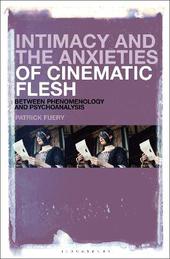
|
Intimacy and the Anxieties of Cinematic Flesh: Between Phenomenology and Psychoanalysis
Hardback
Main Details
| Title |
Intimacy and the Anxieties of Cinematic Flesh: Between Phenomenology and Psychoanalysis
|
| Authors and Contributors |
By (author) Professor Patrick Fuery
|
| Physical Properties |
| Format:Hardback | | Pages:272 | | Dimensions(mm): Height 229,Width 152 |
|
| Category/Genre | Film theory and criticism
Phenomenology and Existentialism |
|---|
| ISBN/Barcode |
9781501376351
|
| Classifications | Dewey:791.43019 |
|---|
| Audience | | Tertiary Education (US: College) | |
|---|
| Illustrations |
25 bw illus, 2 Figures
|
|
Publishing Details |
| Publisher |
Bloomsbury Publishing Plc
|
| Imprint |
Bloomsbury Academic USA
|
| Publication Date |
23 February 2023 |
| Publication Country |
United States
|
Description
In a "return" to Edmund Husserl and Sigmund Freud, Intimacy and the Anxieties of Cinematic Flesh explores how we can engage these foundational thinkers of phenomenology and psychoanalysis in an original approach to film. The idea of the intimate spectator caught up in anxiety is developed to investigate a range of topics central to these critical approaches and cinema, including: flesh as a disruptive state formed in the relationships of intimacy and anxiety; time and the formation of cinema's enduring objects; space and things; the sensual, the "real" and the unconscious; wildness, disruption, and resistance; and the nightmare, reading "phantasy" across the critical fields. Along with Husserl and Freud, other key thinkers discussed include Edith Stein, Roman Ingarden, Maurice Merleau-Ponty, Mikel Dufrenne in phenomenology; Melanie Klein, Ernest Jones, Julia Kristeva, and Rosine Lefort in psychoanalysis. Framing these issues and critical approaches is the question: how might Husserlian phenomenology and Freudian/Lacanian psychoanalysis, so often seen as contradistinctive, be explored through their potential commonalities rather than differences? In addressing such a question, this book postulates a new approach to film through this phenomenological/psychoanalytic reconceptualization. A wide range of films are examined not simply as exemplars, but to test the idea that cinema itself can be a version of critical thinking.
Author Biography
Patrick Fuery is Director and Professor of the Center for Creative and Cultural Industries, Chapman University, USA. He was previously Reader in Film, Royal Holloway, University of London, Professor of Film, Sussex University, UK. He is the author of 8 books in the areas of film, psychoanalysis, phenomenology, cultural theory, and visual cultures. He is currently working on a book on the phenomenology and psychoanalysis of wildness.
ReviewsThe book offers a rare combination of phenomenology and psychoanalysis in describing what we do when view a film. The viewer emerges as the anxiously intimate spectator without whose responses cinema could not exist. Interweaving his theorization with a rich offering of film analyses, the author is inviting us to test our own cinematic experience against the book's interpretations. * Horst Ruthrof, Emeritus Professor FAHA FICI, Murdoch University, Australia * In this scintillating work, Patrick Fuery argues that film creates a new ego and cinema becomes not simply a different art form but an entirely new way of being, experiencing, and knowing. The cinema ego is sensuous and sentient. It creates new object relations and invites different terms - "the projected familiar," "introjected defamiliarization" that open different intellectual and emotional vistas. "To be a film spectator," he writes, "is to take up an othered consciousness," and this brave and brilliant book provides its readers with the conceptual tools to engage this new otherness. A work for all of us to read. * Christopher Bollas, , Psychoanalyst and Independent Scholar, USA * An extraordinary book and compulsory reading for all those interested in the visual history of the human body. * Javier Moscoso, Research Professor of History and Philosophy of Science, Institute of Philosophy of the Spanish National Research Council (CSIC), Spain, and author of Pain: A Cultural History (2012) *
|